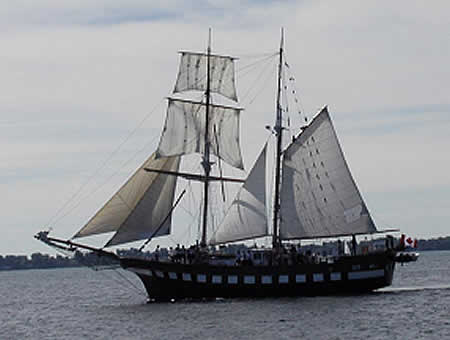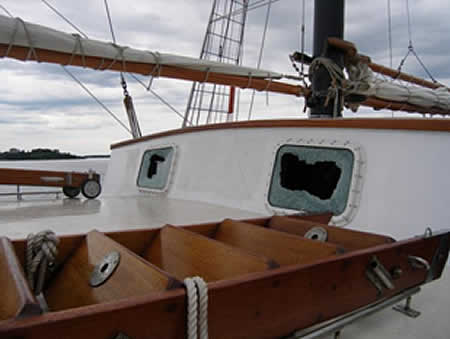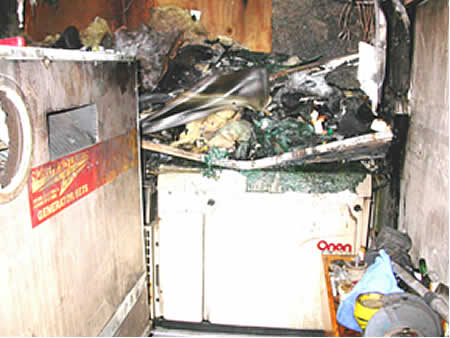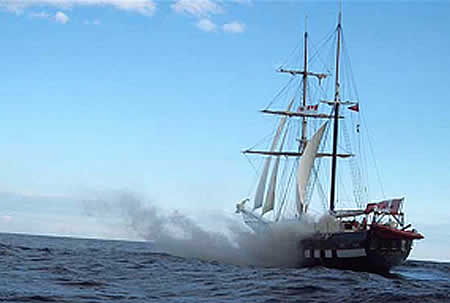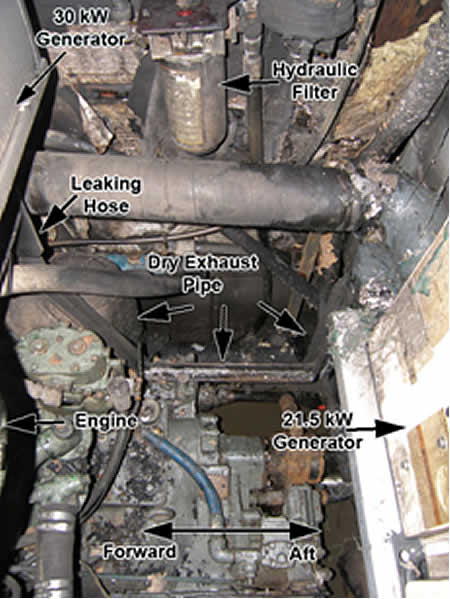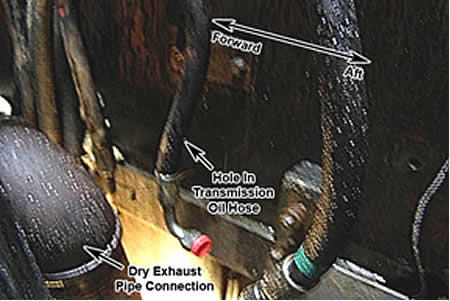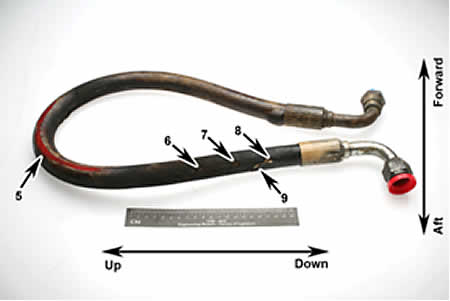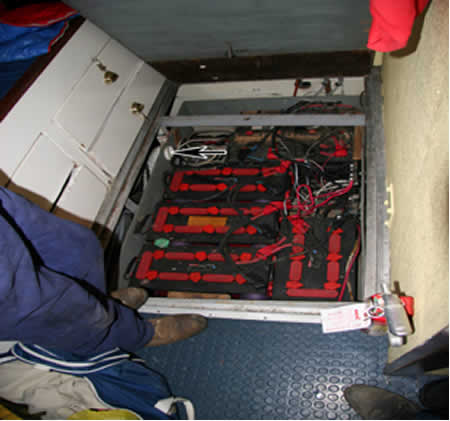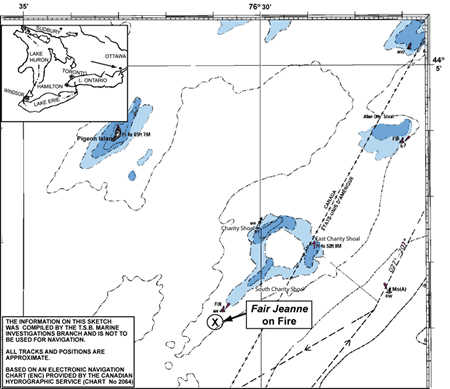Engine room fire
Sail training vessel Fair Jeanne
Off Amherst Island, Lake Ontario, Ontario
The Transportation Safety Board of Canada (TSB) investigated this occurrence for the purpose of advancing transportation safety. It is not the function of the Board to assign fault or determine civil or criminal liability. This report is not created for use in the context of legal, disciplinary or other proceedings. See Ownership and use of content. Masculine pronouns and position titles may be used to signify all genders to comply with the Canadian Transportation Accident Investigation and Safety Board Act (S.C. 1989, c. 3).
Summary
On 13 July 2007 at approximately 1600 eastern daylight time, a fire broke out near the auxiliary propulsion engine of the sail training vessel Fair Jeanne off Amherst Island near Kingston, Ontario. After initial firefighting attempts, the 20 sea cadets on board, along with several crew members and two naval personnel, were evacuated. Volunteer firefighters extinguished the fire. The vessel was towed to Kingston to assess the damage. One cadet received minor injuries.
Factual information
Particulars of the vessel
| Name | Fair Jeanne |
|---|---|
| Official number | 391893 |
| Port of registry | Ottawa, Ontario |
| Flag | Canada |
| Type | Sail training vessel (registered as a pleasure craft) |
| Gross tonnage | 138.36 |
| LengthFootnote 1 | 20.57 m |
| Draught | Forward: 1.7 m Aft: 1.7 m |
| Built | 1981 |
| Propulsion | Sail and motor - Detroit diesel, model GM 6-71 marine diesel engine, 147 BHP |
| Cargo | N/A |
| Crew and others | 9 crew members, 2 naval personnel, and 20 sea cadets |
| Registered owner | Private owner |
| Operator | Bytown Brigantine Inc. |
Description of the vessel
The sail training vessel Fair Jeanne is an auxiliary brigantine constructed of steel and fibreglass with 418 m2 of sail area and a retractable keel. Navigational instruments on board include radar, fixed and handheld GPS, an echo sounder, magnetic compass, and two VHF radiotelephones, one of which is handheld.
The Fair Jeanne's auxiliary propulsion is provided by a single diesel engine connected to a reduction gear and propeller. The engine's water-jacketed exhaust manifold runs along the starboard side of the engine, which is connected to a dry-exhaust pipe. This section of pipe runs aft, down toward and along the bilge, and then back up and aft, out of the engine room.
The vessel was equipped with a 30-kilowatt (kW) Northern Lights generator fitted longitudinally in a rectangular box over the engine. In addition, a 21.5 kW Onan generator was fitted in a rectangular box athwart ships against the aft bulkhead of the engine room. Neither generator was in use at the time of the occurrence.
History of the voyage
The Fair Jeanne was chartered by the Department of National Defence (DND) as an introductory sail training vessel for sea cadets. Prior to the contract being finalized, DND conducted an inspection of the vessel to verify that it met their requirements for training and safety.
On 12 July 2007, the Fair Jeanne, using its engine, departed anchorage for the Royal Military College of Canada (RMC) in Kingston, Ontario. As the vessel was under way, a petty officer informed the master that a routine safety check in the engine room had revealed a stream of oil coming from the housing of the transmission's hydraulic oil filter. The housing was subsequently looked at and, although oil residue was visible, the source of any leak was not apparent.
Once the vessel was alongside its berth at RMC, the master called the vessel's regular mechanic in Ottawa. With his advice, the source of the leak was found. The oil filter was removed from the housing and attempts were made to purchase a new filter and O-ring in Kingston. A new filter was found, but the O-ring was not the correct size for the housing. The filter was reassembled that evening and the old O-ring, which had been cleaned, was put back in place using high-pressure and high-temperature Teflon sealant. The master judged this repair acceptable to allow the vessel's departure.
At 0600Footnote 2 on 13 July 2007, the Fair Jeanne departed RMC using the engine. On board were nine crew, two naval personnel and 20 sea cadets aged 14 and 15 years old. The master requested that, in addition to the rounds to be made every 30 minutes, particular attention be paid to monitoring the filter in the engine room for leaks. At 1000, the Fair Jeanne set sail and shut down the engine. Sail was reduced around 1500 due to strong winds and adverse weather conditions. The engine was started and, as most of the cadets were seasick, the vessel headed for a calm anchorage for the evening.
At 1615, the Fair Jeanne was proceeding toward Prinyer's Cove, Ontario, via the Upper Gap off the Bay of Quinte, Lake Ontario, when a ship's petty officer notified the master of thick smoke in the engine room.
The master proceeded to the engine room and saw flames along the dry-exhaust pipe. The master extinguished the flames using a CO2 extinguisher at the entrance of the engine room. At this point, the smoke and CO2 forced the master to leave the engine room. The master dogged the door, verbally raised the alarm, and shut down the main engine.
All hands promptly mustered on the main deck and were accounted for. Hatches were closed, the vessel's position was plotted on the paper chart in useFootnote 3, and the chart was brought on deck. Handheld radios and the ship's cellular telephone were also retrieved to ensure communications. The engine room remote fuel shut-off valve was activated and access to accommodations below decks was sealed off. Two fire pumps were started and a team composed of cadets and crew members began a chain of fire buckets to provide boundary cooling for the deck.
Around 1630, the master reported the situation to the Prescott Coast Guard radio and a Mayday relay was broadcast on VHF channel 16.
With heavy smoke still escaping the closed engine room hatch cover, the engine room's fixed CO2 firefighting system was activated from the deck. Buckets were used to continuously cool the deck near the engine room, a hose sprayed water into the engine room via a vent in the hatch, and the smoke began to diminish.
At 1730, the Canadian Coast Guard (CCG) search-and-rescue (SAR) cutter Cape Hearne arrived and sent two crew members to assess the situation on the Fair Jeanne. One cadet, who had received a minor head injury, was transferred to the Cape Hearne and later sent by MEDEVAC to Kingston for further assessment. The cadet was released from hospital that evening.
The cadets, wearing lifejackets, were evacuated by the CCG cutter's fast-rescue craft (FRC) to the Cape Hearne, along with three crew members and the two naval personnel. This left six senior crew members and one CCG crew member on board.
With minimal smoke now coming from the engine room, the pumps were temporarily shut off. Approximately 5 to 10 minutes later, however, smoke again began billowing from the engine room and, with the fire apparently re-igniting, both pumps were re-started. Water was pumped into the engine room via the forward vent in the hatch and the fire buckets were again used to cool the deck above.
Subsequent firefighting activities
By about 1830, eight vessels were on scene, including the fire boat Last Chance, from Clayton, New York, U.S.A., as well as a helicopter and a Hercules SAR aircraft from Trenton, Ontario. As firefighters from the Last Chance approached the Fair Jeanne, they noted grey smoke billowing from the vessel (see Photo 4).
Upon request, four volunteer firefighters boarded the Fair Jeanne. Two of them donned self-contained breathing apparatuses (SCBAs) to fight the fire in the engine room, while the other two assisted with equipment on deck. No international shore connections were fitted, nor were they required. The hoses and pumps from the Fair Jeanne were used, as the fire-hose couplings from the Last Chance did not match the onboard fittings.
When the firefighters first opened the main cabin door, dense heavy smoke billowed out, reducing visibility inside to zero. Firefighters therefore requested that the fire-support team on the main deck break windows to ventilate (see Photo 2). This improved visibility and allowed firefighters to make their way down to the engine room door. When this door was opened, extremely hot, heavy, black smoke billowed out, and a large amount of flame rising one metre above the engine room floor was observed on the starboard side of the auxiliary engine.
After extinguishing the engine room fire, firefighters noted a small amount of smoke still issuing from the engine room. Further investigation disclosed that the fire had spread into the insulation between the engine room deck head and the main deck floor. The insulation was removed and this secondary fire was extinguished.
Due to an accumulation of firefighting water, vessel stability became a concern; the Fair Jeanne's portable gasoline-powered pumps were used to remove an estimated one-metre depth of water from the crew's quarters, most of it on the starboard side. After striking the remaining sails, the Cape Hearne towed the Fair Jeanne toward Kingston, where arrangements had been made to meet with a local tow boat, the Windigo. Under tow of the Windigo, the Fair Jeanne arrived at RMC at 0230 on 14 July 2007.
Damage to the vessel
The vessel's engine room had extensive heat, smoke, and water damage. An inspection of an engine room shelf that had collapsed revealed damage patterns indicative of localized hot spotsFootnote 4 (see Photo 3) and the remains of burned/melted plastic containers were found on the shelf. It was discovered afterwards that flammable goods had likely been stored openly on a shelf in the engine room, thus contributing to the fire.
Several deckhouse windows were broken for ventilation and the accommodation had extensive smoke and water damage.
Onboard firefighting equipment
Firefighting equipment on board the Fair Jeanne included two portable gas-powered pumps, buckets, axes, extinguishers, and hoses. In addition, the engine room was equipped with a fixed CO2 firefighting system. The equipment did not include protective firefighter coats or SCBAs, nor were these required.
Post-occurrence testing
Transmission oil filter
Post-occurrence testingFootnote 5 of the hydraulic filter showed that the seal provided by the O-ring and Teflon sealant was ineffective. This caused a small leakage of a few drops of oil per minute. Furthermore, the location of the filter unit at the time was such that any leakage dropped onto the dry exhaust below.
Transmission oil hose
Post-occurrence testing revealed that, when the engine was running, transmission oil sprayed from a leak in the transmission hose onto the hot section of the dry-exhaust pipe. Further investigation found that the hose had a small slit, which likely pre-dated the fire. In addition, when the engine was shut down, the transmission oil level was checked and the sump was almost empty.
The investigation revealed that the hose was worn and may have been part of the original equipment installed on board in 1981. An examination of other hoses and lines in the engine room did not reveal any components that may have broken or failed prior to the fire.
Battery storage arrangement
A post-occurrence inspection of the engine room's electrical wiring revealed that the compartment housing the main house-and-electronic battery bank was located within an accommodation space - on the lower deck in the after port side stateroom/cabin. Ventilation was intended to be provided by a plastic hose connected to the compartment (see arrow in Photo 8). This hose ran under the sole and up through a closet to a vent on the main deck. The vent, however, was found sealed and painted over.
Crew training and certification
The certificates held by the master were a Master 500-tonne Near Coastal and a First Mate Intermediate Voyage. This was the master's fifth season in command of the vessel.
The mate held a Watchkeeping Mate certificate and had previously served three seasons as a petty officer. This was his first season as a mate.
The remaining seven crew members held no certificates of competency or marine emergency duties (MED) certificates, but had sailed on the vessel for various lengths of time over the previous seasons.
According to the vessel's letter of compliance (for sail training vessels in Transport Canada's Ontario Region) the Fair Jeanne is required to carry one certificated master (350-tonne minimum), one certificated mate (Watchkeeping Mate certificate minimum) and five deckhands (each with MED training in courses A2, B1, and B2).
By comparison, the United States Coast Guard Marine Safety Manual, Volume III, Marine Industry Personnel, provides information and program interpretations on statutory and regulatory issues relating to the manning of sailing school vessels operated by the U.S. Merchant Marine and state Maritime Academies. In addition to taking into consideration the vessel's route and specific characteristics, vessels equipped with one or more masts must carry a seaman (able seaman or deckhand, as appropriate) for each mast and an additional able seaman for each square-rigged mast.
Standards for sail training vessels
At present, no mandatory standards address sail training vessels in Canada. TP 13313, Standards Relating to the Design, Construction and Operational Safety of Sail Training Vessels, is a reference document developed in 1999. Compliance is voluntary. A number of issues have arisen as a result, including:
- Registration: This is inconsistent across Canada, as some sail training vessels are registered as pleasure craft;
- Crewing: Sail training vessels registered as pleasure craft are not subject to the requirements of the Marine Personnel Regulations and are not required to carry master, mate, and certificated engineers;
- Letter of Compliance (LOC): Voluntary inspections leading to LOCs are issued to sail training vessels by Transport Canada (TC) in Ontario. However, TC inspectors have limited guidance regarding the requirements for issuing such a letter;
- Age of trainees: As part of a sail training vessel's requirements, the active participation of trainees - some of whom are as young as 13 - are often considered by an operator to be essential to the efficient operation of the sailing vessel. This effectively makes them crew members. The Marine Personnel Regulations, however, set a minimum age of 16 for persons employed, engaged, or working on a Canadian vesselFootnote 6;
- Passengers: Some sail training vessels offer cruises and carry passengers other than trainees as a way of raising funds. However, they are not built, inspected, or certified as passenger vessels; and
- Foreign sail training vessels sailing between Canadian ports: Foreign vessels applying for a coasting license are inspected to Canadian standards prior to being granted a permit. However, there are no applicable Canadian standards addressing sail training vessels.
Safety management
The company operating the Fair Jeanne did not have a formal safety management system (SMS) in place, nor was an SMS required. Although there were some written policies and procedures available on board, these did not provide guidance to the crew for routine and preventative maintenance, or when operating the vessel under routine or emergency circumstances.
There are particular risks associated with sail training operations, such as the dangers of working with heavy sails and rigging under strain, working aloft, the isolated environment, and the number of inexperienced trainees/cadets who may not be available to assist in times of emergency. Effective safety management requires all organizations, large or small, to be cognizant of these operational risks, to be competent to manage those risks, and to be committed to operating safely. However, there is no regulatory requirement in Canada for operators of sail training vessels to practice safety management.
In an occurrence involving the sail training vessel Picton Castle, the Board found that, in the absence of an effective safety management structure, there is the risk that unsafe conditions and practices will not be identified and addressed. Believing that the overall safe operation of sail training vessels could be enhanced through the adoption of comprehensive safety management practices, the Board expressed concern that measures being taken by TC may not result in the adoption of effective safety management systems on board sail training vessels under Canadian jurisdiction. The Board therefore encouraged TC to adopt a proactive approach with the specific objective of an early introduction of SMS for sail training vessels.
Furthermore, the Board was concerned that foreign sail training vessels calling at Canadian ports may not have an effective SMS. The Board therefore encouraged TC to take a proactive position at the International Maritime Organization (IMO), to bring all sail training vessels within the scope of the appropriate international conventions.
Previous similar occurrences
The TSB has investigated other instances of engine room fires caused as a result of oil spraying onto hot engine exhaust manifoldsFootnote 7, and TC has issued two Ship Safety Bulletins (SSB 13/1985 and SSB 08/2000) in this regard. These bulletins are distributed to the marine community at large through a voluntary distribution list, and they serve to alert the end users to issues that TC considers significant, so that users may assess risks to their operations. The SSBs are also circulated among TC inspectors for instruction and guidance, and are available on the TC web site. Both bulletins strongly recommend that attention be given to the following:
- the integrity, vulnerability to damage, and wall thickness of fittings during inspection of fuel, lubricating, and hydraulic oil piping installations;
- the possibility of fitting shields at connections to contain or deflect oil spray in the case of breakage and drainage of any leakage to a drip tray;
- the fitting of sheathing around lagging if there is a possibility of it being subjected to oil leaks from any source;
- the frequent checking of the condition of lagging, oil pipework, and fittings; and
- any maintenance or replacement of fuel and lubrication oil pipework or components is to be accomplished with due regard to the potential hazards involved and using replacement parts that comply with the specifications for the systems or the components.
Analysis
Source of the fire
To determine the source of the blaze, fire and smoke patterns were studied by reviewing photographs taken the day after the occurrence, and by examining damage patterns on underlying material exposed during repairs.
During the occurrence, a large amount of flame was originally observed aft on the starboard side of the engine room. Analysis indicates that the seat of the fire was also in this area, at the base of the dry section of the engine exhaust pipe, near the bilge. The hydraulic filter was located above this section of pipe - which was wrapped with a thin layer of insulating material - and the leaking transmission oil hose was located nearby.
The most intense fire damage was concentrated in this vicinity and appeared to expand outward, gradually diminishing in intensity with a corresponding increase in soot deposits on the aft wall.
Although the oil filter was leaking, it was not likely causal as the small leakage rate observed during post-occurrence testing was insufficient to generate the extensive damage/fire pattern observed. The probable cause and origin of the fire, therefore, is the failure of the transmission oil hose, which sprayed transmission oil onto the hot section of the engine exhaust pipe. The hose itself failed as a consequence of a small slit - most likely caused by old age - that developed in its side wall. A lack of shielding then allowed the fire to spread across the aft end of the engine room, being fed by the combustible material stored openly on the shelf.
Standards for sail training vessels
Crew training and certification
It is noteworthy that two fire drills were conducted for all on board on the day before the occurrence and initial firefighting activities undertaken by the ship's complement were conducted in a reasonable manner.
Operating a sail training vessel can be a demanding endeavour, however, requiring a large number of people for sail handling. The physical effort of sail handling and dealing with emergencies can require the combined efforts of trainees and crew members.
It is incumbent upon the vessel operator to ensure a sufficient number of well-trained crew members to respond to any emergencies. Only the master and the mate had formal MED training and neither had training in crowd control or crisis management. As a consequence, the level of crew training and experience and the number of officers on board constituted a risk that firefighting capabilities might not be adequate.
Preparedness to respond effectively to an emergency requires that the crew be knowledgeable and skilled. Without suitable training, crew members may not be fully prepared to meet the demands of an actual emergency, to the detriment of vessel safety and those on board.
Construction / inspection
Sail training vessels are not held to an equivalent level of safety as passenger vessels. There are no mandatory standards, nor are sail training vessels required to be inspected by Transport Canada (TC). The Fair Jeanne had been inspected, however, under TC's regional policy for compliance.
During its investigation, the TSB noted several unsafe conditions on the Fair Jeanne:
- The engine room could not be adequately sealed in the event of a fire.
- The vessel was not equipped with adequate equipment on board for fighting fires. Firefighters, for example, could not connect to the vessel's firefighting system due to incompatible connections and the master did not have proper personal protective equipment to enter a hazardous area.
- Flammable goods were likely stored openly in the engine room near a heat source.
- The battery compartment was located within an accommodation space and was not adequately ventilated. This could allow toxic fumes from the lead acid batteries to travel throughout the accommodation.
- The transmission oil hose and hydraulic filter assembly were in substandard condition.
Small passenger vessels are required to meet the requirements of TP 1332Footnote 8 or TP 11717Footnote 9 depending on their size and number of persons carried on board. On the other hand, TP 13313 provides minimum voluntary standards for the design, construction, and equipping of sail training vessels and does not include guidance on vessel registration, crew sizes, training/certification, or onboard safety practices and procedures. As a consequence, sail training vessels are not held to an equivalent level of safety as passenger vessels, exposing the vessel and those on board to risks beyond those inherently found in sail training operations.
In the absence of the requirement for sail training vessels to have safety management systems, other forms of oversight, such as mandatory standards, become important. Currently, however, the standards applicable to sail training vessels are voluntary: construction, inspection, and crewing varies from vessel to vessel, with the result that safety cannot be assured.
Findings
Findings as to causes and contributing factors
- The fire likely started when the transmission hose failed, spraying oil onto the hot exhaust pipe.
- The hose failed as a consequence of a small slit - most likely caused by old age - that developed in its side wall.
- Lack of shielding allowed the fire to spread to flammable materials stored openly in the engine room.
Findings as to risk
- The standards applicable to sail training vessels are voluntary; therefore, construction, inspection, and crewing varies from vessel to vessel, with the result that safety can not be ensured.
- Sail training vessels are not held to an equivalent level of safety as passenger vessels, potentially exposing the vessel and those on board to risks beyond those inherently found in sail training operations.
Safety action
Action taken
Transport Canada
Canadian standards for sail training vessels
On 05 December 2007, Transport Canada (TC) met with members of the Canadian Sail Training Association (CSTA) to review the draft of TP 14829 - Training Standards for Sailing Vessels for onboard training. A subsequent meeting was held in January 2008. Currently, work is being done by CSTA to develop training manuals and to seek TC approval. It is anticipated that a draft standard will be submitted at the national Canadian Marine Advisory Council meeting in spring 2009.
TC has begun updating the Standard Relating to Design, Construction, and Operational Safety of Sail Training Vessels (TP 13313). A meeting was held in January 2009 between the CSTA and TC to create a joint working group with the intention of addressing changes to TP 13313, as well as safety concerns surrounding the inspection, crewing, and operation of these vessels.
TC has also begun the process of implementing a policy as an interim measure until requirements for sail training vessels are developed under the Special-purpose Vessel Regulations. Under the policy, a Canadian sail training vessel undertaking sail training activities may choose to comply with the requirements of TP 13313. Alternatively, the vessel may be certified as a passenger vessel, in which case, it must meet all of the applicable provisions of the Canada Shipping Act, 2001, and its regulations. Sail training vessels choosing to comply with TP 13313 will be limited to structured sail training activities only. Operations such as short cruises, sometimes used as fund-raising activities, will not be permitted as they are considered passenger operations.
Fair Jeanne
TC has required the operator of the Fair Jeanne to make extensive modifications to the vessel in order to bring it into compliance with TP 13313. In addition, TC has required the operator to implement a ship and shore-based safety management system.
Owner
During a post-occurrence refit in August 2007, hydraulic lines and associated equipment were relocated and the dry exhaust pipe was redesigned in a P-trap shape. Thicker insulation was also applied in way of the lower part of the exhaust. Additional work included:
- Relocation of the battery storage box to the engine room in accordance with a design submitted and approved by TC;
- Installation of a complete sprinkler system throughout the vessel that can be activated from the exterior deck, independent of any machinery in the engine room. This allows below-deck spaces to remain sealed, making it unnecessary for anyone to don self-contained breathing apparatus (SCBA) gear to fight a fire in those areas;
- Replacement of all wooden blocking - used for mounting equipment on insulated walls - with aluminum;
- Replacement of the gasket on the hatch to a non-combustible material;
- Removal of all insulation down to bare wood, painting the wood with fire-retardant paint, and installation of new insulation;
- Installation of a second set of CO2 canisters as backup for the engine room's fire-suppression system;
- Alteration of the engine room to ensure its air-tightness in the event of a fire; and
- Replacement of the fuel hose as per Transport Canada's SI-7 form (The hose installed prior to the fire had no visible rating stamped on it. The new one is a stamped, United States Coast Guard-approved hose.)
This report concludes the Transportation Safety Board's investigation into this occurrence. Consequently, the Board authorized the release of this report on .
